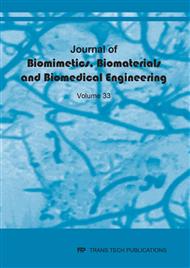[1]
G. Lecloux, M. Lamy, La mise en charge immédiate en réhabilitation orale implantaire, Rev Med Liège 2007: Synthèse 2006 , 62 (2007) 36-41.
Google Scholar
[2]
M. Davarpanah, H. Martinez, Implant large : indications, avantages et réflexions. Implant 1998; 4 : 275-277.
Google Scholar
[3]
Lorraine Hoff , influence des traitements de surface implantaire sur l'accélération de l'ostéo-integration", université de lorraine , faculté d, odontologie, ( 2012).
Google Scholar
[4]
S. Szmukler-Moncler, M. Davarpanah, P. Rajzbaum, P. M. Khoury, Protocoles de mise en charge et de temporisation immédiates, 19 (2013) 7-34.
Google Scholar
[5]
T. Degorce, Les implants de larges diamètres, Synergie prothétique, 2, (2000) 365-377.
Google Scholar
[6]
Y. Sato, M. Wadamoto, K. Tsuga and E.R. Teixeira, The effectiveness of element downsizing on a three-dimensional finite element model of bone trabecular in implant biomechanics, J Oral Rehabil, 26 , (1999) 288–291.
DOI: 10.1046/j.1365-2842.1999.00390.x
Google Scholar
[7]
S. Sahin, M.C. Cehreli and E. Yalçın, The influence of functional forces on the biomechanics of implant-supported prostheses—a review, J Dent, 20 , (2002) 271–282.
Google Scholar
[8]
L. Kong, Zexu Gu , K. Hu, Hongzhi Zhou , Y. Liu et B. Liu, Optimization of the implant diameter and length in type B/2 bone for improved biomechanical properties: A three-dimensional finite element analysis, Advances in Engineering Software, 40, Issue 9, (2009).
DOI: 10.1016/j.advengsoft.2008.12.010
Google Scholar
[9]
O. Kayabaş, E. Yüzbasıoğlu et F. Erzincanl, Static, dynamic and fatigue behaviors of dental implant using finite element method, Advances in Engineering Software, 37, (2006) 649–658.
DOI: 10.1016/j.advengsoft.2006.02.004
Google Scholar
[10]
C. lin, Y. kuo, T. sheng lin, effects of dental implant length and bone quality on biomechanical responses in bone around implants: a 3-d non-linear finite element analysis, Biomed Eng Appl Basis Comm, ), 17, (2005) 44-49.
DOI: 10.4015/s1016237205000081
Google Scholar
[11]
C. Lee,S. Lin, M. Kang, Effects of implant threads on the contact area and stress distribution of marginal bone, J Dent Sci, 5(3), (2010) 156−165.
DOI: 10.1016/s1991-7902(10)60023-2
Google Scholar
[12]
S. Faegh, S. M¨ uft ¨, Load transfer along the bone–dental implant interface, Journal of Biomechanics , Elsevier , 43, (2010) 1761–1770.
DOI: 10.1016/j.jbiomech.2010.02.017
Google Scholar
[13]
T. Li, K. Hub, L. Cheng, Y. Ding, Y. Ding ,J. Shao , L. Kong , Optimum selection of the dental implant diameter and length in the posterior mandible with poor bone quality – A 3D finite element analysis, Applied Mathematical Modelling, 35 , (2011).
DOI: 10.1016/j.apm.2010.07.008
Google Scholar
[14]
C. Liang-jian, H. Hao, L. Yi-min, L. Ting, G. Xiao-ping, W. Rui-fang, Finite element analysis of stress at implant−bone interface of dental implants with different structures, Nonferrous Met. Soc. China, 21, (2011) 1602−1610.
DOI: 10.1016/s1003-6326(11)60903-5
Google Scholar
[15]
P. Vena , R. Contro, Micromechanical Analysis of the Trabecular Bone Stress State at the Interface with Metallic Biomedical Devices, Meccanica 37, (2002) 431–439.
Google Scholar
[16]
L. Vidyasagar, P. Apse, Dental Implant Design and Biological Effects on Bone-Implant Interface, Stomatologija, Baltic Dental and Maxillofacial Journal, vol. 6, (2004) 51-54.
Google Scholar
[17]
H. chou, J. Jagodnik, S. Mu ftu , Predictions of bone remodeling around dental implant systems, Journal of Biomechanics, 41 , (2008) 1365–1373.
DOI: 10.1016/j.jbiomech.2008.01.032
Google Scholar
[18]
Z. Q. Lian, H. Guan, Y. C. Loo, Optimum Degree of Bone-Implant Contact in Bone Remodelling Induced by Dental Implant, Procedia Engineering , 14, (2011) 2972–2979.
DOI: 10.1016/j.proeng.2011.07.374
Google Scholar
[19]
D. Lin, Q. WeiLi, N. Duckmanton, M. Swain, Mandibular bone remodeling induced by dental implant, Journal of Biomechanics , 43, (2010) 287–293.
DOI: 10.1016/j.jbiomech.2009.08.024
Google Scholar
[20]
Z. Lian, H. Guan, S. Ivanovski, Y-C. Loo, N. W. Johnson, H. Zhang, Effect of bone to implant contact percentage on bone remodelling surrounding a dental implant, Internationel Journal of Oral Maxillofacial Surgery, 39 (2010) 690–698.
DOI: 10.1016/j.ijom.2010.03.020
Google Scholar
[21]
U. Lekholm and G. Zarb, Patient selection and preparation. In: P.I. Brånemark, G. Zarb and T. Albrektsson, Editors, Tissue-integrated protheses. Osseointegration in clinical dentistry, Quintessence, Chicago, (1985) 199–209.
Google Scholar
[22]
Zimmer dental, – Implant dentaire zimmer® tapered screw-vent®, Compendium Scientifique ; ©2014 Zimmer Dental Inc. ZD1380FR, Rév. 4/14, (2014).
Google Scholar


